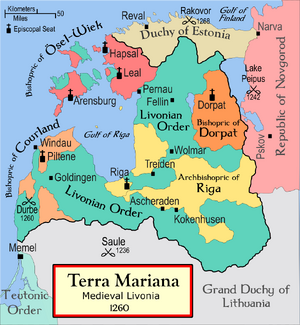| Battle of Rakvere | |||||||
|---|---|---|---|---|---|---|---|
 Map showing the location of the Battle of Rakvere in the context of the 13th century Livonia. |
|||||||
|
|||||||
| Belligerents | |||||||
| Pskov Republic Novgorod Republic | Livonian Order | ||||||
| Commanders and leaders | |||||||
| Daumantas of Pskov Dmitri Aleksandrovich of Pereyaslavl | Otto von Lutterberg | ||||||
| Strength | |||||||
| 16,000[1] — 30,000 troops[2] | 25,000 troops[1] | ||||||
| Casualties and losses | |||||||
| 5,000 troops[2] | 12,000 troops[1] | ||||||
The Battle of Wesenberg, Rakvere or Rakovor was a battle fought on February 18, 1268, between the Livonian branch of the Teutonic Knights and a coalition of Russian princes. The Knights were beaten so thoroughly that they would not undertake a new campaign against Northern Russia for the following thirty years.
The two armies clashed within 7.5 kilometers (roughly 4.5 miles) from the Livonian town of Wesenberg (Rakvere, Rakovor). Russian forces, numbering up to 30,000 troops, were led by Dmitri Aleksandrovich of Pereyaslavl (representing the Novgorod Republic) together with his future son-in-law, Daumantas of Pskov(representing the Pskov Republic).
Apart from the knights, the Livonian army included Danish forces (right flank) and local Estonian militia (left flank). The crusading army was led by the Livonian Ordensmeister Otto von Lutterberg.
The German forces deployed in their customary deep "boar's head" wedge of heavily armoured knights, called by the Russians the "great iron pig." These deep wedges had considerable penetrative power, but were unmaneuverable and vulnerable to flank attack due to the resulting narrow frontage of the army, facts which led to the ultimate defeat of the Knights at the Battle of Lake Peipus. As a result, the Germans attempted to remedy this situation at Rakvere by splitting their knightly assault force into two formations, deploying one wedge in the open and a second in ambush, so that when the first wedge was attacked on all sides by the Russians the second wedge would burst from ambush and in turn encircle the enemy.
The tactic worked well at first, as the wedge of German knights smashed the Novgorod and Pskov forces facing them, but then the second wedge, seeing the Russians in retreat, apparently assumed the battle was won and emerged from their ambush position to loot the Russian baggage. This abandonment of the battle plan led to the first wedge being encircled.
The fighting to reduce the first wedge was apparently terrific. "Neither our fathers nor grandfathers have witnessed such a terrible battle", reports the Novgorodian First Chronicle.[3] At last the Novgorodian militia prevailed, although its leader, the posadnik Mikhailo Fyodorovich, was killed in action.
The Russian princes pursued the knights up to Rakvere. Prince Daumantas of Pskov, whose bravery was recognized even in the German chronicles of the battle, pursued the defeated knights all the way to the coast of the Baltic Sea, and took substantial booty before returning to the Russian lines. Upon his return to his camp, [[Dmitri Aleksandrovich of Pereyaslavl (c1250-1294)|Dmitri Aleksandrovich of Pereyaslavl] discovered that it had been looted by another regiment of the knights. He decided to wait for the morning. Three days passed and no new attack ensued on the part of the knights. The Russian leaders claimed victory and returned to Novgorod in triumph.
References[]
- Nicolle, David. Medieval Russian Armies 1250 - 1450. Oxford: Osprey Publishing, 2002.
| This page uses content from the English language Wikipedia. The original content was at Battle of Rakvere (1268). The list of authors can be seen in the page history. As with this Familypedia wiki, the content of Wikipedia is available under the Creative Commons License. |